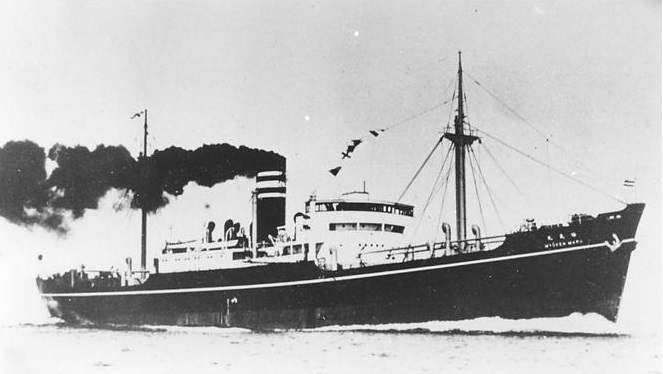KOKAI HOKAN!
 (MYOKEN MARU, prewar)
(MYOKEN MARU, prewar)
IJN MYOKEN MARU:
Tabular Record of Movement
© 2023 Gilbert Casse, Berend van der Wal and Peter Cundall
26 March 1938:
Laid down by Harima Zosensho as a 4,124-tons cargo ship for Nippon Yusen K.K.
18 July 1938:
Launched and named MYOKEN MARU.
30 September 1938:
Completed and registered at Tokyo. Her gross registered (GRT) tonnage and net registered tonnage (NRT) respectively are 4,124-tons and 2,262-tons. Her call sign is JHXL. [1]
8 October 1938:
In service on the Kobe ~ Shanghai, China route. Sails once every ten days.
31 July 1939:
Departs Shanghai.
1 September 1939:
Her new owners are Toa Kaiun K.K.
May 1941:
Departs Shanghai.
20 May 1941:
Arrives at Tokyo.
25 August 1941:
Requisitioned by the IJN.
5 September 1941:
Registered as an auxiliary gunboat attached to the Sasebo Naval District under instruction No. 1025. Rated as an auxiliary gunboat engaged in minelaying under instruction No. 1026. Navy Capt. Iwahara Morie (36) is appointed CO that same day.
1 October 1941: BR>
Navy (Resv) LtCdr Yagi Katsuji is appointed CO.
15 October 1941:
Attached to the First Gunboat Division under order No. 1250. Tactically attached to Vice Admiral Takahashi Ibo’s (36) Third Fleet, First Base Force, First Gunboat Division also consisting of auxiliary gunboats BUSHO, KEIKO and KANKO MARUs.
23 October 1941:
Nagasaki. Mitsubishi Kogyo K.K. Shipyard completes conversion for military duty.
November 1941:
Assigned to the 4th Assault Group.
27 November 1941:
Departs Terashima Suido.
December 1941:
Receives 4th Assault Group Order No. 2:
First Gunboat Division, 2nd Escort Group generally remains at the anchorage rather than departing from the assembly point.
Second Division Minelaying Unit generally relocates after berthing at the harbor.
Third Division Supply Team under light cruiser NAGARA command and 24th destroyer squadron will depart after leaving the harbor.
12 December 1941:
Arrives at Legaspi, Philippines. Departs there later this day.
15 December 1941:
Arrives at Palau, Western Carolines.
17 December 1941: Invasion of Lamon Bay, Southern Luzon, Philippines:
Imperial General Headquarters launches the combined IJA and IJN Lamon Bay Operation. The Army force consists of Gen (later Field Marshal) Count Terauchi Hisachi’s Southern Expeditionary Army. Its 14th Army, under Lt-Gen Homma Masaharu, fields MajGen Morioka Susumu's Invasion Unit of about 7,000 troops consisting of elements of the 16th Infantry division: 20th Infantry, 22nd Field Artillery, HQ and II Battalion, 16 HQ Coy, 16th Eng Battalion, 16th Recon Battalion, 3/45 AA Coy, 16th Transport, 16th Signal Coy, 16th Med Unit and 16th Vet Unit. Two AA and one Signals Regiment are stationed on IJA transports (Yusosen).
The invasion units are embarked on 20 IJA transports: BENGAL, DAINICHI, DURBAN, KAIMEI, KAYO, KITANO, KOFUKU, LISBON, NAGATO, NICHIREN, RYOKA, RYUYO, SHINSEI, SHINSHU (4,182 GRT), TAIAN, TATSUNO, TOFUKU, TOYAMA and TOYOHASHI MARUs and TAMON MARU No. 5.
The naval force consists of Vice Admiral (later Admiral) Kondo Nobutake's (35) (former CO of KONGO) Southern Force, Philippines Invasion Group that includes Vice Admiral Takahashi Ibo’s (35) (former CO of YAMASHIRO) Third Fleet. Rear Admiral (later Vice Admiral) Kubo Kyuji’s (38) (former CO of KAGA) Invasion Unit consists of his 1st Base Force HQ, in light cruiser NAGARA, 1st Quartermaster Ports and Docks Unit and 1st Naval Signal Unit, aboard HAKUSAN MARU, 1st Naval Guard Unit, aboard KIMISHIMA MARU, 1st Naval Survey Unit in SENKO MARU and Captain (later Vice Admiral) Mori Kunizo's (40) (former CO of SATA) Sasebo No. 1 and 2 Combined Special Naval Landing Force (SNLF) aboard MYOKO MARU.
The convoy’s escort consists of light cruiser NAGARA (F), heavy cruiser ASHIGARA, destroyers TOKITSUKAZE, YUKIKAZE, KAWAKAZE, SUSUKAZE, UMIKAZE, YAMAKAZE, minelayer AOTAKA, minesweepers W-7 and W-8, auxiliary gunboat/minelayer IKUSHIMA MARU, auxiliary gunboats BUSHO, KANKO, KEIKO and MYOKEN MARUs, auxiliary subchasers SHONAN MARU No. 17 and TAKUNAN MARU No. 5 and auxiliary netlayer FUKUEI MARU No. 15.
18 December 1941:
Departs Palau.
24 December 1941:
Arrives at Lamon Bay, Philippines.
26 December 1941:
At 0900, departs Lamon Bay with BUSHO, KANKO and KEIKO MARUs and Patrol Division 21 escorting minelayer AOTAKA and others.
31 December 1941:
Arrives at Palau.
3 January 1942:
Departs Palau.
8 January 1942:
Arrives at Malalag Bay, Philippines.
9 January 1942:
Departs Malalag Bay.
12 January 1942:
Arrives at Legaspi.
14 January 1942:
Departs Legaspi.
17 January 1942:
Arrives at Davao, Philippines.
19 January 1942:
Departs Davao.
21 January 2942:
Arrives at Banka, Celebes, Netherlands East Indies (now Sulawesi, Indonesia).
24 January 1942:
Departs Bangka. Arrives at Kema Bay, Celebes, Netherlands East Indies (now Labuan/Teluk Kema, Sulawesi, Indonesia) later this day. Torpedoed by LtCdr (later Rear Admiral) Chester C. Smith’s (USNA '25) USS SWORDFISH (SS-193). Sinks at 01, 22N-125, 05E, Kema Bay anchorage. Six of the crew are killed.
5 February 1942:
Detached from the First Gunboat Division under order No. 224. Removed from the Navy’s list under order No. 226.
Authors' Notes:
[1] NRT is a ship's cargo volume capacity expressed in "register tons", one of which equals to a volume of 100 cubic feet (2.83 m3). It is calculated by subtracting non-revenue-earning spaces i.e. spaces not available for carrying cargo, for example engine rooms, fuel tanks and crew quarters, from the ship's gross register tonnage (GRT). Net register tonnage (NRT) is not a measure of the weight of the ship or its cargo, and should not be confused with terms such as deadweight tonnage or displacement.
Thanks go to Gengoro S. Toda of Japan.
- Gilbert Casse, Berend van der Wal and Peter Cundall.
Back to the Auxiliary Gunboats Page





